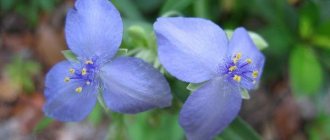Primrose is one of the first spring flowers, a herbaceous perennial of the Primrose family. The genus Primula includes about 500 species. And every year new varieties appear that decorate the areas of ornamental plant lovers.
How to grow primrose from seeds, what is the peculiarity of sowing and picking, how to care for plants during the growing season - Natalya Konstantinova , a passionate gardener from the Moscow region, will tell you about this.
Natalya Konstantinova is a breeder of ornamental plants, the author of a blog dedicated to growing popular perennial flowers. Articles by Natalya Konstantinova can be found in the magazines “Vestnik Florist”, “Kitka” and other publications, as well as on websites and forums of flower growers.
Every year I sow primroses for breeding purposes. I tried many different ways to grow seedlings. For myself, I long ago decided on the simplest and most reliable method of cultivation, which I want to share with those who are just mastering this science.
On the Internet you can find many tips for growing primroses from seeds. Sometimes such information is contradictory, since each grower has his own experience, which is not always suitable for all types of primroses. In addition, it often happens that certain manipulations with seeds and crops are carried out with amazing persistence, and it does not occur to any gardener that such “procedures” are completely unnecessary: for example, the notorious cold stratification, in which most primrose seeds, especially hybrid origin are not needed at all.
In this article I will share my experience in growing the most common and popular primroses: polyantha (P. polyantha), hybrids of high primrose (P. elatior hybrids), stemless (P. acaulis), Siebold primrose (P. sieboldii), auricula primrose (P . auricula), etc.
General information
Primrose, also known as primrose, belongs to the Primrose family, order Heather. The name is “inspired” by the fact that most representatives of the genus bloom in early spring, as soon as the snow melts. Primrose began to be cultivated in ancient times, when it was called the flower of “12 gods”. In most cultures, magical properties are attributed to the primrose - somewhere its flowers were considered a key that could open any “passage”, find a treasure, somewhere they were part of love potions or were considered a protective talisman.
In nature, primroses live along mountain streams or in damp grassy valleys. The distribution area is quite wide - most species are found in Asia and Europe. Some grow in Africa, America, and the Middle East. Wild primrose is not uncommon in the mountains of Crimea, Transcaucasia and the Carpathians.
Most primroses are perennial or annual flowering herbs. The leaves are entire, often wrinkled and toothed, with slight pubescence; their shape depends on the species. They form a basal rosette. The rhizome is short, thick, with many superficially located roots. The flowers are five-petaled, widely funnel-shaped, and can be solitary or grouped into umbellate or racemose inflorescences. Primrose blooms from April to mid-summer.
Growing primrose in different parts of the world has become possible due to its high adaptive abilities. This is a frost-resistant plant, and at the same time it tolerates summer heat well. Some species are suitable for growing indoors.
Requirements for landing tanks
There are no special requirements for planting containers for primroses. These can be food containers, packaging left over from food, plastic trays, special mini-greenhouses.
The main thing is that the container has a transparent lid and holes in the bottom to drain excess liquid. Primroses are quite miniature and at first can grow in a common container. In the future, the seedlings will need to be planted into separate cups or small pots.
Popular types and varieties
The genus Primroses is one of the most numerous; More than 400 of its representatives have been found in nature in different parts of the world, and new species of primrose continue to be found to this day. In this regard, the classification is regularly updated. A little less than a third is cultivated. To facilitate “accounting,” the genus of primroses is divided into subgenera.
| Subgenus name | Description | Popular varieties of primroses |
| Primula orchid or Viala | Biennial. The leaves are elongated, up to 30 cm, lanceolate, with a finely toothed edge. The flower arrow is tall, up to 15 cm; inflorescences are conical, consist of many small bell-shaped flowers with a pleasant aroma | In gardens it is found in two variations: red-lilac and red-white. |
| Ordinary (stemless), or garden | Perennial. The leaves are oblong-lanceolate, rounded, toothed, strongly wrinkled. The flowers are funnel-shaped, up to 4 cm in diameter; collected in dense sessile inflorescences | Akaulis is a popular series with brightly colored petals and a contrasting “eye” in the center. Matryoshka is a series sold in the form of a mixture of seeds; It is distinguished by its compact, up to 20 cm, bush size. Virginia – white; with a yellowish core |
| Siebold | Perennial. The leaves are ovate-oblong, covered with grayish hairs. The flowers are small, collected in dense inflorescences of 12-15 pieces. | Late Snow – snow-white petals with a carved edge. Kumor – soft lavender flowers. Pink primrose is one of the hybrids, the name of which has not been preserved, with a light center and a darker edging of the petals |
| Chinese | Perennial. The leaves are heart-shaped, divided into 7 lobes. Flowers are about 2-3 cm in diameter | Stellata - a series with white, blue and red petals and a yellow core |
| Serrated | The leaves are dark green, lanceolate, rounded, embossed, with a corrugated edge; covered with silver hair. Collected into a tight socket. The peduncle is tall, up to 30 cm. The inflorescences are umbellate, large | Alba - snow-white bell-shaped flowers with a yellow core, collected in a large “ball”. Violet – purple, with a lighter core. Rubra – dark ruby, with a yellowish center |
| Cortusoid | Perennial. The leaves are ovate, covered with soft wavy hairs. Corolla up to 2 cm in diameter, petals heart-shaped | There are white varieties with a red core and reddish varieties with a white center. |
| Ushkovaya | The leaves are smooth, spatulate, obovate; covered with a grayish coating. Peduncle up to 20 cm in height, flowers are medium-sized, collected in inflorescences of 6-7 pieces; have a pleasant aroma | Suzanne is double, with wavy tonal pinkish petals and a yellow center. Blue Wave - bluish-violet petals with radial strokes. Zambia – dark red double flowers |
| High | The leaves are wrinkled, lanceolate, pubescent on both sides. The flowers are small, collected in inflorescences of 25-30 pieces. | Colossea - crimson petals with a bright yellow center. Duplex - bright crimson petals with a yellow center |
| Japanese primrose and bullea | The leaves are oblong-oval, up to 25 cm in length, with a serrated edge. Peduncle up to 50 cm; large dense inflorescences | Apple Blossom - pinkish petals with a crimson eye. Valley Red – cherry monochromatic flowers |
Sometimes natural species are also found in gardens, for example, spring primrose, also known as “ram” or “keys”. Its golden inflorescences resemble a bunch of keys, which, according to legend, open the “door to summer.”
The diversity of primroses is constantly increasing thanks to the work of breeders. The main “material” for work at the moment is the auricular primrose, on the basis of which two-, three-color and fancy hybrids, both simple and double, have been bred. Another variety of primrose that is actively used for breeding purposes is obconika (reverse conical). It is cultivated not only as a garden crop, but also as a potted crop.
Description of the plant
The international name of this flower is primrose (lat. Primula). The genus Primulaceae, to which primrose belongs, is one of several members of the Primrose family. It contains at least 390 species, most of which grow in temperate climates. These are all herbaceous crops, including both annuals and perennials.
Common primrose (Primula vulgaris) is the most common garden primrose. The height of the plant is 10–30 cm. It is characterized by the presence of a rosette of leaves close to the ground, with a short stem in the center.
Botanical description of the genus Primrose:
- distribution area: temperate zones of western and southern Europe;
- in its natural environment it grows under bushes in deciduous forests, in clearings, roadsides, near railway tracks, in open pastures; in areas rich in humus, sometimes on stony loams;
- flowering: February - March;
- flowers: pale yellow with green veins; 2–4 cm in diameter, grow on thin stems;
- fruit: seed capsule;
- pollinators: insects;
- leaf rosette: basal;
- leaves: 5–25 cm long, 2–6 cm wide, wrinkled, gradually tapering towards the stem, with a jagged edge.
Role in landscape design
Primrose is used widely in the garden: in single or group plantings, for decorating rockeries, rock gardens, borders, garden vases and containers. The moisture-loving primrose can be used to frame fountains, ponds and streams. The best “neighbors” of primrose in landscape design are hostas, ferns, irises, phlox, and hellebores. It is good to plant primrose next to early flowering bulbous plants; it opens at the same time as them and prolongs the “life” of the composition. Thus, primroses can be used to frame hyacinths, daffodils, and tulips.
The versatility of primrose is also due to the fact that it can be planted both in open areas and in light partial shade, under the canopy of perennial shrubs. Primrose looks good in combination with peonies, roses, compact deciduous or coniferous shrubs. The most unpretentious ones, spring primrose and common primrose, can be planted even under trees.
We recommend reading
Rules for planting petunias for seedlings: when to plant, care
Features of growing and propagating hostas, planting and care
Planting gladioli and caring for them in open ground
Planting and caring for Rhododendron in open ground
Growing primrose seedlings from seeds
Most often, primrose is grown from seeds. They can be purchased in specialized stores or assembled yourself. When purchasing, pay attention to the collection date - the seeds quickly lose their viability.
The seed material is stratified by placing it in the freezer for a month, except for serrated and common primrose, which do not need freezing. The time for sowing primrose is late October - early November. You can also sow in the spring, in mid-February - March, which makes caring for seedlings at home much easier.
Sowed in containers or boxes with drainage holes and a mandatory layer of expanded clay at the bottom. The soil for primrose is made up of leaf soil, sand and peat (4:2:1). The substrate is moistened, compacted with the palm of your hand and the seeds are laid out on the surface so that there are no more than 5 seeds per 1 cm2. Cover with film and place in a well-lit place with a temperature of 18-20 °C. The exception is high primrose and Siebold - these species germinate in the dark. Ventilate the soil daily and, if necessary, moisten the soil with a mist stream, preventing it from drying out.
When planting in spring, the seedlings hatch within 2 weeks; when planting in autumn, within a month. The cover is removed after another few weeks. Primrose seedlings grow slowly. After 3-4 true leaves appear, they are planted in larger containers at a distance of 10-15 cm. After picking, greenhouse conditions are not needed. Seedlings are kept in bright light, regularly watered and treated with a pinkish solution of potassium permanganate.
Seasonal features
- Planting primrose in the spring is carried out after the establishment of consistently positive temperatures in April - May. Flowering is expected in a year.
- In the summer, you can sow seeds that are just ripe and collected directly into the ground. This is carried out at the end of July - August.
- Pre-winter planting of primrose is considered the most effective. The plant does not require additional care; it is enough to protect the plants with covering material before the onset of cold weather. Flowering is possible as early as next spring.
Planting primrose in open ground
Primrose seedlings are unpretentious and, when planted correctly and in a good location, rarely get sick or freeze.
What is the best time to plant
When to plant primroses in open ground depends on when the seedlings were sown. “Winter-winter” seedlings are planted in the spring, in April – early May, and they bloom in the first year. Those sown in the spring, accordingly, are transplanted to a permanent place in the fall, in September, and they will begin to produce buds only in the next season.
What is the best place to plant primroses?
For planting primroses, it is better to choose areas that are partially shaded during the midday hours, for example, located on the eastern side of buildings or large trees and shrubs. With an abundance of direct sunlight, primroses die. The place should be well ventilated. Close occurrence of groundwater is allowed. If there are drainage channels, it will also tolerate planting in lowlands where melt water accumulates in the spring.
Soil preparation
This primrose is picky about soil composition. For full development, it needs slightly acidic, nutritious, moisture-intensive and at the same time breathable soil. Before planting, the garden soil is “ennobled”: it is dug up, mixed with rotted humus, coarse river sand and high-moor peat mixed with chopped sphagnum moss (3 kg, 8 kg and 5 kg per square meter, respectively). At the same time, the roots of weeds are selected. In areas with heavy, compacted or low-nutrient soil, the top layer of soil up to 30 cm deep is completely replaced. In such cases, loose loam is used as an earthen “base”.
Landing technology
Primrose planting is carried out as follows:
- In a pre-prepared area, planting holes are made at a distance of 15 to 30 cm, depending on the size of the bushes.
- The holes are pre-watered.
- The seedlings are removed from containers with a lump of earth, being careful not to damage the roots.
- Move primroses into planting holes without deepening them.
- Add soil, compact it lightly and water again.
Primrose is planted in the evening or on a cloudy, cool day. After planting, be sure to mulch. For 3 weeks, until complete rooting, make sure that the soil does not dry out.
Photo
Below you can see a photo of a perennial plant that can be grown as a garden or indoor plant:
Caring for primrose in open ground
Caring for primrose in open ground is not difficult if the planting site is chosen correctly. To achieve abundant flowering, it is enough to maintain a certain level of soil moisture, regularly loosen it and remove weeds. Perennial primroses are planted every 3-4 years so that they do not crowd each other and do not lose their decorative effect. To prevent the root collars from being exposed, several centimeters of a mixture of nutrient soil, peat and sand are added to the site annually. One of the “secrets” of successfully growing primrose is mulching, which will help protect the surface root system from drying out and overheating.
For some varieties, for example, serrated and Japanese primula, leaves are plucked out, leaving no more than 2-3 on the bush. This is the only way to achieve abundant flowering from them.
Watering and fertilizing
Watering primrose in open ground is an important aspect of its successful cultivation. Lack of moisture is detrimental to primroses; in the absence of natural precipitation, they are watered abundantly and regularly. It is especially difficult to tolerate water starvation in the spring, at the time of budding, reacting to it by shedding the ovaries. At the same time, most primroses do not tolerate waterlogging. Water between the rows, trying not to get into the centers of the rosettes, which can cause rot.
They begin to feed primrose in April, immediately after the first leaves appear. At this time, nitrogen fertilizing is applied to stimulate the growth of green mass, for example, nitroammophoska. Primrose responds well to the addition of organic matter: infusion of cow manure (1 kg per bucket of water) or bird droppings (100 g per bucket of water). From the beginning of May until the end of flowering, they begin to fertilize primrose with phosphorus-potassium mixtures at intervals of 2 weeks. After flowering, feeding is stopped. Overwintering bushes can be fed again in October with potassium sulfate to help them prepare for winter.
Care after flowering. Preparing for winter
Caring for primrose after flowering comes down to removing flower stalks, hilling and watering. Many species produce buds repeatedly. It is better to prune them so as not to weaken the bushes before frost. The leaves are not cut off until early spring - they additionally protect the roots from freezing. In late autumn, the bushes are covered with fallen leaves, sawdust, straw or peat with a layer of up to 10 cm. The mulch is covered with branches on top to prevent it from being blown away by the wind. In the southern regions, caring for garden primrose does not require additional shelter for the winter.
Possible diseases
The cause of most primrose diseases is excess soil moisture. These include:
- Gray rot.
- Root collar rot.
- Leaf spotting.
Primroses are treated with fungicides and, of course, the soil moisture level is optimized. Damaged parts of plants are removed. Periodically, primroses are affected by aphids and caterpillars. To protect plants, insecticides of the latest generations are used.
Primrose combines amazing decorativeness and ease of care. These are one of the first flowers that delight our eyes in early spring. And the variety of types and colors of primroses makes your eyes wide open. New varieties and hybrids are constantly appearing.
Primroses deservedly enjoy the love of many flower growers around the world. In many countries, societies of connoisseurs of these wonderful flowers have been created, festivals and exhibitions are held, the popularity and prevalence of this plant is constantly growing.
Primrose propagation
Primrose propagation is usually carried out by seeds. But seed collected from hybrids will not transmit parental characteristics. These varieties of primrose are propagated by dividing the bush and using root or leaf cuttings. Root cuttings, or babies, are formed only in Primula auricula and serrata. They are separated from the mother rosettes in the spring and cared for like ordinary seedlings.
Most primroses can be grown from leaf cuttings:
- Large leaves are cut obliquely. The cut is treated with crushed activated charcoal or charcoal.
- Prepare containers and fill them with a mixture of peat and sand (1:1).
- The cuttings are planted with a slight slope and placed in greenhouses. Keep in a shady place.
- Roots appear after 2-3 weeks, then babies form at the base of the cuttings.
- After the appearance of 2-3 true leaves, the children are planted. They are cared for like seedlings.
Perennial primroses can be divided in the 3rd-4th year of cultivation. This procedure allows not only to obtain young trees, but also to rejuvenate overgrown bushes. They dig up and divide the bushes in early spring. Each part should have independent roots and several growth points. The cut areas must be sprinkled with coal. Plant as seedlings, preventing the roots from drying out. Dividing and replanting primroses are easy to tolerate and quickly take root in a new place, provided there is sufficient watering. Flowering primrose cannot be replanted. Large divisions bloom in the same year. Primrose can be replanted and divided in the fall, in September, but this increases the risk of freezing in winter.
Possible diseases and pests and ways to get rid of them
The most harmless pests that can harm garden primrose are snails and aphids. As a rule, they appear if the climate is too humid or if the primrose plantings are too thick. There are several methods to get rid of snails.
For example, some use a special granular preparation called Groza. It would also be a good idea to place spruce needles around the plants. Slugs and snails do not like to move on rough or scratchy surfaces.
However, it is first very important to remove them mechanically, that is, you will need to collect all the snails in a container and remove them as far as possible from the plant or burn them.
In order to get rid of aphids, it is necessary to wash all primrose leaves with a weak soap solution, in which any dishwashing detergent is added. If the insect colonies are already too large, then an insecticide will be required. For example, the drug Biotlin or Iskra is highly effective.
Primrose may also suffer from powdery mildew. That is a fungal type disease that first damages the lower leaves, and then rises higher and destroys the entire plant. At the first stage of development of powdery mildew, a light coating appears on the leaves, which is quite easy to wipe off. But then peculiar drops of liquid appear.
They are a product of the maturation of fungal pores. If they are fully formed, it will be very difficult to save the flower, since the damage to the foliage will be irreversible. Therefore, experienced gardeners recommend periodically inspecting the leaves of plants, especially from below.
If the first signs of the development of powdery mildew appear, then you need to treat with Topaz or Fitosporin. If the plants are severely affected, it is better to dig them up and burn them, as powdery mildew can quickly spread to other flowers.
Primrose also sometimes suffers from gray rot. In this case, unpleasant yellow spots appear on the shoots of the plant, around which a brown border forms. Similar signs can be seen when rust appears.
Only in this case the spots are distinguished by a uniform red-brown tint. Gradually, the spots merge and affect the plant with a cavity. Another sign of rust development is the appearance of tubercles on the bottom of the leaf in which spores collect.
Primrose may suffer from:
- Anthracnose. An unpleasant dark coating and small brown spots appear on the leaves, around which there is a yellow or brown border.
- Downy mildew. Transparent spots form on the outer part of the leaf, and whitish mold can be found on the inside of the leaf plate.
- Chlorosis. The leaves become colorless and the buds become deformed. The plant begins to grow much slower and blooms very little.
When these diseases (including rust and gray rot) appear, it is necessary to get rid of the infected parts of the plant, and treat the sections with crushed activated carbon. After this, you need to spray the plants with fungicide and pour a small amount into the soil.











